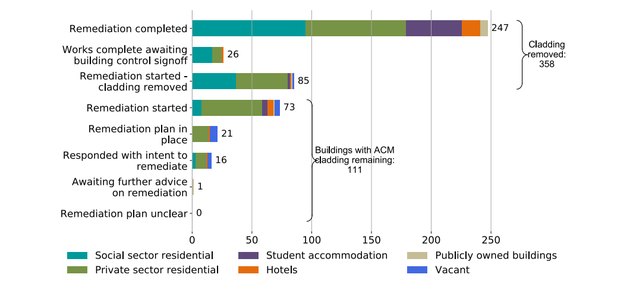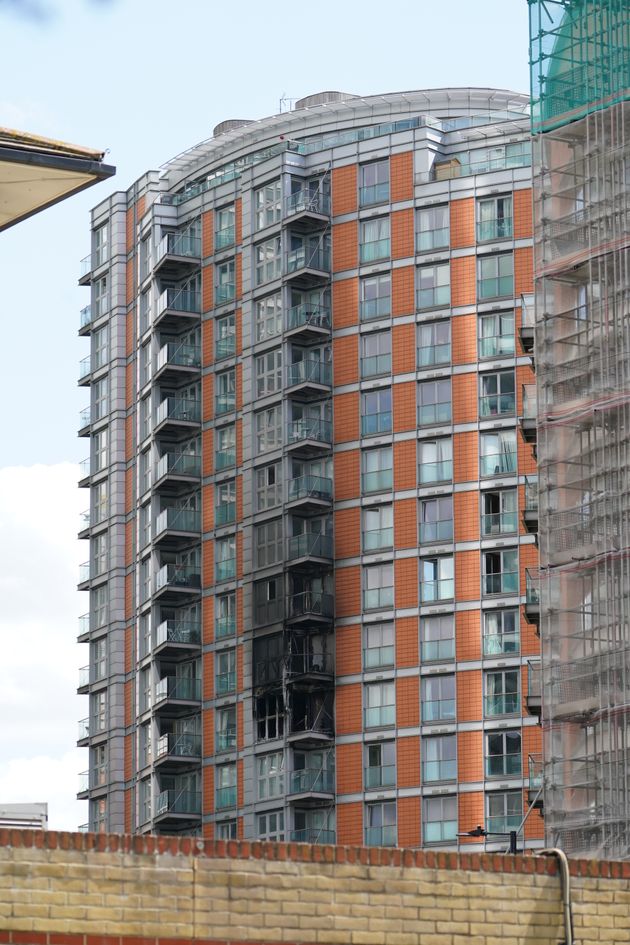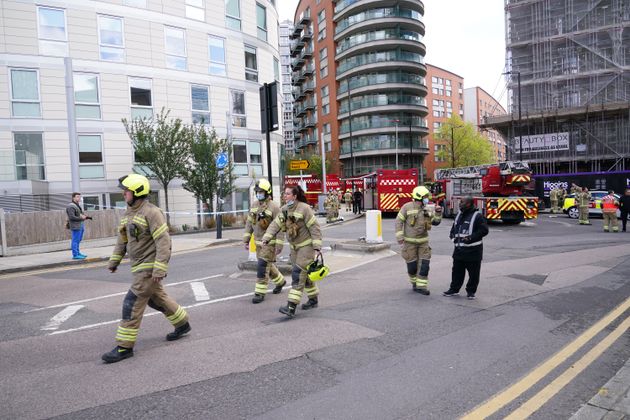The government has been condemned for its slow response to the cladding scandal after a fire at a London block covered in the same flammable material as Grenfell Tower left than 40 people in need of medical treatment.
London Fire Brigade said two adults had gone to hospital after suffering the effects of smoke inhalation and a further 38 adults and four children were treated at the scene after the fire ripped through the 19-storey New Providence Wharf development, near Canary Wharf, on Friday morning.
Approximately 22% of the building’s facade features aluminium composite material polyethylene (ACM PE) cladding panels, which were found to be a key factor in the 2017 Grenfell fire.
The latest official figures show that 111 residential buildings in England have yet to have ACM fully removed almost four years after the disaster, which killed 72 people. In the wake of the fire, the government vowed that dangerous cladding would be replaced on all high rise buildings by June 2020. By that time, 300 buildings were still vulnerable.
Some 358 buildings no longer have ACM cladding systems after the government committed £5 billion to make buildings safe, but the scandal has since widened as a plethora of faults have been found in people’s homes and more types of cladding have been deemed unsuitable.

Labour’s shadow housing secretary Thangam Debbonaire said: “The government must take full responsibility. Ministers promised this dangerous cladding would all be removed by June last year. They failed to keep this promise.
“It is a disgrace that, four years on, this tower still had the same cladding as Grenfell – and four years on, we are yet again seeing the horrifying results of inaction.”
Survivors and bereaved relatives from Grenfell have told the government “enough is enough”.
Survivors’ and relatives’ group Grenfell United said in a statement: “We are horrified by the news of the fire at the New Providence Wharf today. When will the government take this scandal seriously? Enough is enough.
“The government promised to remove dangerous cladding by June 2020 – it has completely failed its own target and every day that goes by lives are at risk. Today more people have lost their homes in another terrifying fire.
“The government needs to treat this as an emergency and stop stonewalling residents who are raising concerns. No more games, no more excuses.”

The cladding crisis has deepened during a stand-off between developers, private freeholders, who own the buildings, and government over who is responsible for removing the flammable material.
In the meantime, blameless freeholders who own the flats have been left with a financial and emotional burden, which gets worse each day.
Aside from the fear of living in a building liable to catch fire, an increasing number of buildings have been forced to introduce expensive 24/7 fire patrols to stay safe.
In February, HuffPost UK revealed 794 blocks of flats in England and Wales have so-called “waking watches” in place, which are costing some individuals as much as £1,500 a month – the same as a second mortgage payment.
We reported last week how the government has failed to recover a penny of the £450m it is giving to landlords to fix unsafe cladding – despite promising to get tough with those responsible for installing the highly dangerous material.
Last week, the government’s Fire Safety Bill, introduced in response to the deadly 2017 blaze, is set to leave hundreds of thousands of leaseholders paying to remove dangerous cladding from their buildings.
Although the Government had insisted that leaseholders would not bear the cost of removing the flammable materials, critics say the Bill will leave people liable for costs of up to £50,000.
Mayor of London Sadiq Khan said: “The spectre of the tragedy at Grenfell still hangs over our city. Today we have seen again why residents in buildings with flammable cladding are living in fear.
“It is vital that government, developers, building owners and regional authorities work together to urgently remove the cladding from every affected building.”
Work to replace the cladding was “under way” and the main contractor had been due to take possession of the site on Monday, according to building developer Ballymore.
Pictures and videos on social media show part of the building engulfed in flames, with thick grey smoke pouring out of the block, several stories high.
One resident posted on Instagram: “When your building has the same cladding as Grenfell Tower. Oh my god.”
The fire comes just days after the introduction of the Government’s post-Grenfell fire safety regulations, which campaigners argue could leave leaseholders paying tens of thousands of pounds to remove cladding on their buildings.

Fire Brigades Union general secretary Matt Wrack said: “It is extremely alarming to see another high-rise building in the heart of London light up in flames.
“It should shame this Government that four years on from Grenfell, there are people across the country living in buildings wrapped in flammable cladding.
“Time and time again we’ve warned that another Grenfell could be just around the corner unless they prioritise making people’s homes safe.
“The pace of removing flammable cladding has been glacial and it’s putting people’s lives at risk. The Government must intervene and take quick and decisive action to end our building safety crisis once and for all.”
LFB said parts of the eighth, ninth and 10th floors were alight on the building, adding that it had received 13 calls to the fire.
It added: “The brigade was called at 0855. Fire crews from Poplar, Millwall, Shadwell, Plaistow, Whitechapel and surrounding fire stations are at the scene.
“The cause of the fire is not known at this stage.”
Apsana Begum, the Poplar & Limehouse Labour MP, said: “For years now, constituents at New Providence Wharf, where there are 1,500 apartments, have been left vulnerable and unsafe due to numerous fire safety and building safety defects and the fact that ACM cladding remains on these buildings.
“The fire this morning shows just how serious this issue is and why constituents have been right to continue to raise alarm bells for so many months and having met with them again I know just how terrified they must be feeling at this time.”
“The developer Ballymore have promised action, but to date, constituents have not received information on fire engineer reports and details of any remediation works.”
She added: “It is simply not good enough for developers to say that they cannot act or that they are and then do nothing. They must act now and the government must act now and hold them accountable in order to protect residents.”
Sir Ed Davey, leader of the Liberal Democrats, tweeted: “My thoughts and prayers are with everyone affected by this awful fire – and with all those for whom it stirs memories and fears.
“It is simply a national scandal that more has not been done by Government to remove this dangerous cladding.”
Ballymore said in a statement: “Our thoughts are with everyone who has been affected by this morning’s fire at New Providence Wharf.
“The safety of our residents is paramount and we are working closely with the London Fire Brigade.
“We can confirm that the fire was quickly brought under control by the Fire Brigade and is now extinguished. Our response team are on-site to support residents and assist with alternative accommodation where necessary.
“We will update once we have more information.”
An MHCLG spokesperson said: “We thank the emergency services for their work to extinguish the fire in New Providence Wharf. As we await their report on the cause of the fire it is too early to speculate, but we are working closely with the London Fire Brigade.
“The building has received £8m government funding to remove unsafe ACM cladding – this work was set to take place on Monday and we have been in regular contact with Ballymore over the last two years to make progress, including publicly naming Landor, their subsidiary, as one of the companies that has consistently failed to take action. Ministers have met Ballymore repeatedly to urge action.
“We are spending £5bn to fully fund the replacement of all unsafe cladding in the highest risk buildings and are making the biggest improvements to building safety in a generation. It is essential that building owners take swift action to remediate defective cladding and the government will fund every eligible application. Workers are on site in 95% of buildings identified as having ACM cladding at the beginning of 2020 and we expect that work to be completed at pace in the coming months.”





